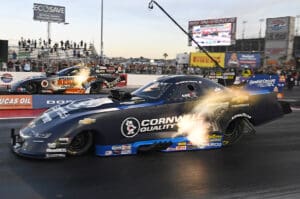
 If David Sharp has his way, the drag strip he took over earlier this season will become the Chick-fil-A of drag strips.
If David Sharp has his way, the drag strip he took over earlier this season will become the Chick-fil-A of drag strips.
Now, if you are among others who might ask, “What does that mean?”
For Sharp, the director of Rocket City Dragway, formerly Huntsville Dragway, the philosophy has nothing to do with chicken and everything to do with how they operate as a race track and an entertainment center. He made the comment to a friend that he wanted the strip to be the Chick-fil-A of drag strips.
“What do I mean by that?” Sharp asked. “When you think of Chick-fil-A, of course, you think of chicken sandwiches, but you immediately go to think of just how efficient they are, how they can process that many people in that short period of time. There is always consistency in the product, and it’s probably one of the premium restaurants you’ll go to. And if I can do those three things at the Dragway, we’re going to make a lot of fans and a lot of racers happy.”
God’s chicken, and now God’s drag strip? Some laughingly make the comparison based on the company’s Christian principles.
“We’re a very spiritual place here, and I want from our side is this environment has got to be more like when most of us were kids and going to the drag strip, and it’s got to be more family-based entertainment,” Sharp countered. “And I’m looking for the shock and awe. And shock and awe, what do I mean?”
Simply put, the family-oriented drag strip has big events planned, including Top Fuel dragsters, the most powerful race cars on the planet, coming to the drag strip in May, something that hasn’t been attempted since a $106,000-to-win nitro shootout back in 2005.
“When you think of Huntsville Dragway, most people forget about us, one of the fastest tracks in the United States at one point,” Sharp said. “When you look at what we did from a standpoint, this was the first place ever to hold the million-dollar race. That was in 1996.”

In 1993, the facility also hosted one of the IHRA’s Nitrous National events.
“I think that one of the things that we as promoters have got to do is, I believe racing is what we’re providing, but we are in the entertainment business,” Sharp explained. “We as the promoters; we as the track owners; we as the drivers; we as the owners of the cars need to understand that.”
Sharp said with a little more work to the facility, which also features a concrete racing surface, concrete barriers, and concrete grandstands, the potential is there for an eighth-mile national event facility. A major race bodes well for the entertainment dollars around a city where he declares intelligence is king.
The Rocket City moniker, Sharp adds, has very little to nothing to do with race cars rocketing down the drag strip.
“Most people are not aware, but Huntsville, Alabama has the largest concentration of PhDs and Master degrees engineers anywhere in the country,” Sharp declared. “We call Huntsville… Alabama Pentagon – South, and that’s just due to the strong influence of defense products that we make for the military. I am very proud to be associated with the military in Huntsville. But our foundation goes back to when the Apollo rocket was built with Wernher Von Braun, and Huntsville being an instrument part, an integral part of building the rocket and putting the first man on the moon.”
Huntsville is also home to the George C. Marshall Space Flight Center, the U.S. government’s civilian rocketry and spacecraft propulsion research center. As the largest NASA center, MSFC’s first mission was developing the Saturn launch vehicle for the Apollo program. In Huntsville, one can see the six million pound, 300-foot long Apollo five-sided rocket.

With this said, Sharp said changing Huntsville Dragway to Rocket City is validated.
 “Changing the name was to let everybody know that we’ve got a strong foundation here with that technological community,” Sharp said.
“Changing the name was to let everybody know that we’ve got a strong foundation here with that technological community,” Sharp said.
Technically, Sharp understands he can host a significant independent event, but he aspires to have a national event facility one day.
“I don’t want to oversell what I’m doing here,” Sharp admits. “This is a new venture for us, and we’ve got to crawl, we got to walk, and then we’re going to run, and we’re going to run fast.”
Sharp clearly wants to make the most of what he’s working with. Rocket City Dragway has 660 feet of concrete racing surface with another 2,200 feet of asphalt runoff. He’s planning to add another 400 feet. It’s currently sanctioned by the IHRA.
“Having a purposely built eighth-mile track for a national event, I think, is something that we, and with the help of some people, could make that a reality,” Sharp said.
Above all, Sharp understands the experience one has visiting his track is important.
“We as promoters and track owners have got to understand that the spectators and fans paid us for a ticket,” Sharp explained. “And the racers need to understand that. They paid to see a show, and we need to complete that show in a timely fashion. Just this trend of running races in the wee hours of the morning, there’s a kid that was there that was with their dad, and they want to see the finals, and we’re going to come up with a plan to make that happen.”
While Sharp understands he’s not the first to invent the drag strip, he hopes to perfect the experience.







































